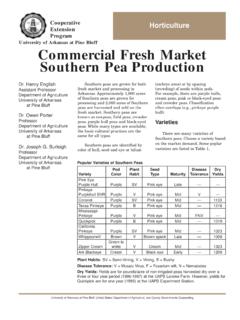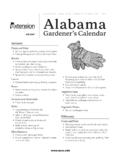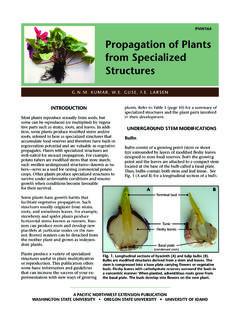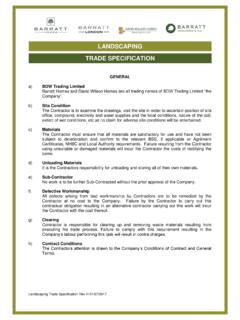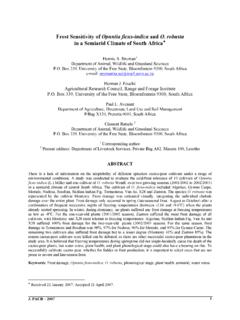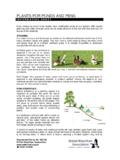Transcription of University of Arkansas at Pine Bluff Fresh Market Southern ...
1 Steve E. IzekorExtension HorticultureSpecialist, UAPBS. O. OkirorAssociate Professor ofAgricultureO. A. PorterProfessor of Agriculture,UAPBMany small farmers in Arkansasgrow Southern peas for consumptionand as a cash crop for the Fresh peas are one of the mostpopular vegetables consumed in theSouth and are grown in most homegardens. They are easy to grow andgenerally yield well. Southern peas,Vigna unguiculata(L) Walp, are alsocalled blackeyed peas, crowder peas,field peas, cowpeas, purple hull peasor just peas. Despite the variability intypes, the basic cultural practices forsouthern peas are similar. The varietyand type grown are determined byconsumer preference.
2 Botanically, Southern peas belong to the legumefamily and are capable of formingnitrogen-fixing nodules on their roots;therefore, little N fertilizer is neededfor good yields. They also add nitrogento soils when vines are turned commercial and smallacreage growers of Fresh Market peasshould select varieties acceptable tothe consumers and processors. Thevarieties should have high yieldpotential and resistance to diseasesand insects. Processors recommendvarieties to be grown by their certified seeds to ensuretrue-to-type seeds with high germina-tion is a good practice. Southern peascome in a variety of seed and podcolors and shapes.
3 They also vary ingrowth habits as shown in Table 1 onpage pea Fresh pods may bepurple, pink, green or white. Commonfresh Market seed types includepinkeye, blackeye, browneye, creameyeand whiteeye on black seededvarieties. Pod maturity can be even,synchronous, needing only oneharvest or uneven,asynchronous,needing more than one plant growth habit can bebush erect, runner, creeping, semi-bush, semi-erect or climbing the years, farmers in southernArkansas have predominantly grownpurple hull pinkeye types for the freshmarket. Table 1 provides informationon varieties adaptable to Arkansasclimate and soils in southeast andeast central from two years ofdemonstration trials at UAPBA griculture Experiment Farm andSmall Farm Outreach ResearchCenters at Lonoke and Mariannashowed AA Cream Gold (GoldenCreamy) variety outperformed othervarieties tested under irrigated andnon-irrigated conditions.
4 However,Golden Creamy is not a purple hullpinkeye, which is most preferred byconsumers in east Arkansas . It is abush erect type pea that can bemechanically harvested. It wasdeveloped by the Texas AgricultureExperiment Station primarily as acanning such as Louisiana PurpleHull (Quick Pick), Texas Pinkeye,Mississippi Pinkeye, CT-CaliforniaPinkeye, Excel, Early Scarlet andCoronet are the most popular withgrowers and consumers in southeastcentral Arkansas . The Quick Pickvariety is probably the most popularbecause of its high yield potential,large pea and erect pod growth habitthat aids in hand or Market Southern PeaProduction in South ArkansasUniversity of Arkansas at pine Bluff , United States Department of Agriculture, and County Governments CooperatingCooperativeExtensionProgramUn iversity of Arkansas at pine BluffTable 1.
5 Popular Southern Pea Varieties and Their CharacteristicsVarietyPodColorPlantHabit *SeedTypeMaturity**Yield(lbs/A) Fresh Pea ShelledYields(lbs/A) Fresh Pea UnshelledCoronetPurpleR/CBrowneyeMedium1 4693154 Texas PinkeyePurpleB/EBrowneyeMedium19863792LA Purple Hull(Quick Pick)PurpleB/EPinkeye17013563CT-Californ iaPinkeye PurpleR/CBrownEarly 15673587 Zipper creamWhiteR/CCreamLate13233108 Ark BlackeyeWhiteR/CBlackeyeEarly20063949 Early ScarletPinkSB/SEPinkeyeMedium26224996 ExcelPurpleB/EPinkeyeMedium19414279MS SilverWhiteR/CBrowneyeLate28104061 Early AcreWhiteB/ECreamMedium17603575 Tex. HullPurpleB/EBrowneyeMedium--Golden CreamyWhiteB/ECreamEarly31055059*Notatio n: B/E = Bush/Erect; R/C = Runner/Creeping; SB/SE = Semi-bush/Semi-erect; CV = Climbing vine**Maturity: Late 80-90; Medium 70-78; Early 63-66 Soil/FertilizerSouthern peas perform well on a wide variety ofwell-drained to somewhat less drained soils.
6 Use soiltest result recommendations when applyingfertilizers. Ignoring soil test analysis may lead toabnormal crop growth poor yield at best and totalcrop failure at pH should be between and If the soilpH is lower than this range, soil test recommendationsmay include a lime application for the current cropand also for the succeeding one. If liming is required,apply lime two to three months before planting dueto its slow reaction in , 20 to 50 pounds of N per acre are neededfor peas, depending on soil types, residual N, rainfallor irrigation and cultural practices such as row widthand plant population. Peas, especially for the freshmarkets, require plenty of potash and phosphorousfor a glossy seed coat and large pods.
7 On soil with amedium level of fertility and a good history of cropproduction, a pea fertilizer program should include20 to 30 pounds N, 40 to 60 pounds P and 40 to 60pounds K fertilizer per acre, broadcast or banded 3 to4 inches deep, 2 to 3 inches from the seed. Additionalnitrogen side dressing may be needed on sandy soilsif the crop is heavily irrigated or heavy precipitationoccurs during early growth stages. Seed inoculationwith recommended Rhizobium bacteria (nitrogen-fixing-bacteria) may enhance yield, especially in soils wheresouthern peas have not been grown for a Bed PreparationPlow to expose the soil and harvest residues tofreezing temperature in order to suppress over-wintering pests.
8 This can be done sometime inFebruary in southeast Arkansas . Just before planting,rework the soil again to destroy any weeds anddevelop a clod-free seedbed that will enhance seedgermination and mechanical harvesting. Use weatherstation and soil thermometer equipment to ensuresoil temperature has been 65 F or above for a coupleof days prior to DatesIn south Arkansas , peas can be planted frommid-spring (early May) through mid-summer (earlyAugust). Early Market growers who plant peas alongwith other vegetable crops on smaller acreage doplant earlier depending on the variety and weatherconditions. A few plants may be lost to chill damage,but high Market prices at the farmers marketoutweigh the risk.
9 In Southern Arkansas , productionrecords showed that late pea production is morechallenging due to insects, especially aphids andthrips. Larger acreage growers, planting early beforeMay, risk poor germination, stunted growth andprolonged maturity caused by chilling the spring, plant after the danger of frost haspassed and soil temperature within the top 4 inchesis 65 F or above. The optimum temperature for peagermination ranges from 70 F to 95 F. Optimumplanting dates for spring and fall peas are the secondweek of May and last week of July, respectively. Smallacreage growers should stagger planting dates tokeep a steady harvest of Fresh peas to the farmersmarket or grocery stores.
10 Fall pea planting should notbe later than the first week of August in southernArkansas. Growing conditions may vary within shortdistances, but the practical approach for fall produc-tion is to seed early enough so that cool temperaturesand frost do not occur before the crop Space At the University of Arkansas at pine Bluffexperiment farms, 30-inch spacing between rows isused, and the yields are comparably satisfactory. Rowspacing of 20 to 42 inches normally produces good peayields depending on the pea type. Bush type peas canbe planted in closer row spacing than vining available planting and harvesting equipmentplay a role in choosing row spacing.
